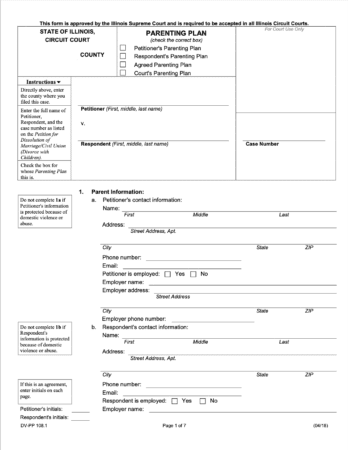Illinois Parenting Plan Template
A parenting plan outlines each person’s parental responsibilities and parenting time. Parenting plans detail how parents will continue to co-parent after their separation. When parties are filing separately, each party submits their own plan. If parties cannot come to an agreement before the end of the case, the court decides on a plan.
Parenting plans are a necessary part of any case that determines parental responsibilities. They make sure that parents are prepared to work together and show parents a road map of their future as parents.
Who Needs a Parenting Plan?
Any parent with a child custody case needs a parenting plan. Child custody is called parental responsibilities in Illinois.
The plan needs to be created and filed within 120 days of the case’s start. If parties are filing together, the start is when they filed. But, if parties are filing separately, it is 120 days after the filing party served the other.[1]
For Immediate help with your family law case or answering any questions please call (312) 757-8082 now!
Parenting Plan
In the above parenting plan, there are 13 steps to creating a parenting plan. Before beginning the plan, it asks for the case information. The petitioner is the person who first filed, and the respondent is the person who they had to serve. The parenting plan uses these terms, so be sure to know which is which.
The information below outlines each step in case you have any questions. If you need further help after this article, call Sterling Lawyers, LLC to meet with an experienced family law attorney.
If you are creating a parenting plan separate from the other party, fill the parenting plan out to reflect what you want to happen. Parenting plans are especially important for parents who plan to co-parent together because it solves things before they can become problematic.
1.) Parent Information
Step 1 requires the personal contact information of each parent. It also requires their employment information.
2.) Children
Step 2 asks which child or children this plan impacts.
If there are more than three children, be sure to check the box below the third name and attach the Additional Minor Children form.
3.) Rights and Responsibilities
Step 3 lists the responsibilities of each parent–nothing needs to be filled out in this step.
4.) Significant Decision Making
Step 4 details whether one or both parents make significant decisions for the child.
5.) Parenting Time
Step 5 has you outline how often each parent has the child on each day of the week. There are sections for weekdays, weekends, holidays, and breaks.
Holidays can either be split in half or day-by-day. Parents can also choose whether to switch off each year or maintain the same schedule.
Seasonal school breaks either keep the normal schedule or have a specialized schedule.
6.) Transportation and Exchange
Step 6 asks you which parent is responsible for picking up and dropping off the child for each exchange.
7.) Exchange of Children
Step 7 continues the previous step to describe where the picking up and dropping off happens.
8.) Right of First Refusal
Step 8 has you decide whether or not each parent has the right of first refusal.
The right of first refusal comes into play when a parent cannot personally take care of the child during their allotted time for 24 hours or more. With the right of first refusal, the parent who will be away from their child first has to offer the time to the other parent before arranging other care.
9.) Communication
Step 9 you set up how to communicate with your child during the other party’s parenting time. Communication must be reasonable and can occur at any time or at scheduled times.
10.) Relocation of Minor Child
Step 10 outlines how a parent goes about moving a significant distance with their child. How the process works is explained, but nothing needs to be filled out in this step.
11.) Designation of Children’s Custody and Residence for Other Purposes
Step 11 asks which parent has the “majority” of parenting time. Listing this does not affect parenting time and responsibilities, but it is necessary for some state and federal laws.
The second piece decides which parent to list as the child’s home for school selection purposes.
12.) Changing the Parenting Plan
Step 12 gives a process to adjust the parenting plan as situations change. The goal is for parents to come to a mutual agreement.
13.) Resolving Disagreements
Step 13 then outlines what to do when parents cannot come to an agreement. If possible, parties first come to an agreement in mediation. As a last resort, the court will decide on the issue when necessary.
How to File a Parenting Plan
First, you review the document to make sure everything is filled out and signed. Then, make three copies, and bring them to your local courthouse. There you file the parenting plan with the Circuit Clerk.
The petitioner usually files the parenting plan with their Petition for Allocation of Parental Responsibilities. The respondent usually files their parenting plan with their Response to Petition.
The clerk will stamp your forms and set your court date. You will also have to pay the necessary filing fees unless you ask for them to be waived.
Are you ready to move forward? Call (312) 757-8082 to schedule a strategy session with one of our attorneys.
Considerations
What Must Be Included in a Parenting Plan?
Parents have the option to create their own parenting plan. The Illinois state statutes outline all the issues that must be in a parenting plan.[2] You can use the numbered list above to see what needs to be included. Or you can check the state statute by following link number two in the references below.
Can a Child Decide Which Parent to Live with in Illinois?
A child cannot choose which parent to live with because they do not always know what is in their best interest. But the more mature the child is, the more their preference will matter in court.
What Happens if Parents Don't Agree on a Parenting Plan?
If parents cannot agree on a parenting plan, the court will decide for them. But parents first go through mediation where a third party helps them come to an agreement. The court prefers parties find a solution together because people are more likely to follow rules they had a say in.
What Does the Court Consider When Ruling on Illinois Parenting Plans?
The court's goal is to decide based on what is in the child's best interest. More specifically, they are supposed to “[maximize] the child's relationship and access to both parents.”[3]
Frequently Asked Questions
What is a parenting plan in Illinois?
A parenting plan outlines each party's parental responsibilities for their child and the amount of time they get with their child. It hammers out the details so the transition goes smoothly.
What should be included in a parenting agreement?
A parenting plan must outline each parent's responsibilities. It should also outline the placement schedule, when each parent will get their child and how the child will get from place to place. A parenting plan should outline, in detail, how parties will keep parenting.
For more information, see the list above.
What is the minimum parenting time in Illinois?
There is no minimum amount of parenting time. In some cases, one party has all of the parenting time. But, most people will get at least every other weekend and extended time during summer vacation.
Is Illinois a mother state?
Illinois is not a mother state. Instead, Illinois is a ‘best interests’ state. Sometimes it is in the child’s best interest for their mother to have the majority of parental responsibilities, but certainly not always. Generally, it is in the child's best interest to have time with and input from both parents.
What is a permanent parenting plan?
A permanent parenting plan is one that will be used after the case finishes. A temporary plan is used during the case. A permanent plan can still be modified if you file for a modification.
What should you not forget in a parenting plan?
There are a lot of small things that become important in a parenting plan. Things like if you get your child on your birthday or who takes the child to their dentist appointments or exact times a child goes to the other parent on a holiday.
How do you negotiate a parenting plan?
The best way to negotiate a parenting plan is to go through mediation. Having a third party to keep things calm and collected helps a lot. Understand that these decisions are really impactful, and the other party is as stressed as you are.
The best thing to do is find what is most important to you and try to work that into what is most important to them.
References: 1. 750 ILCS § 46/602.10 (a). Parenting Plan. | 2. 750 ILCS § 46/602.10 (f). | 3. 750 ILCS § 46/602.10 (g).


